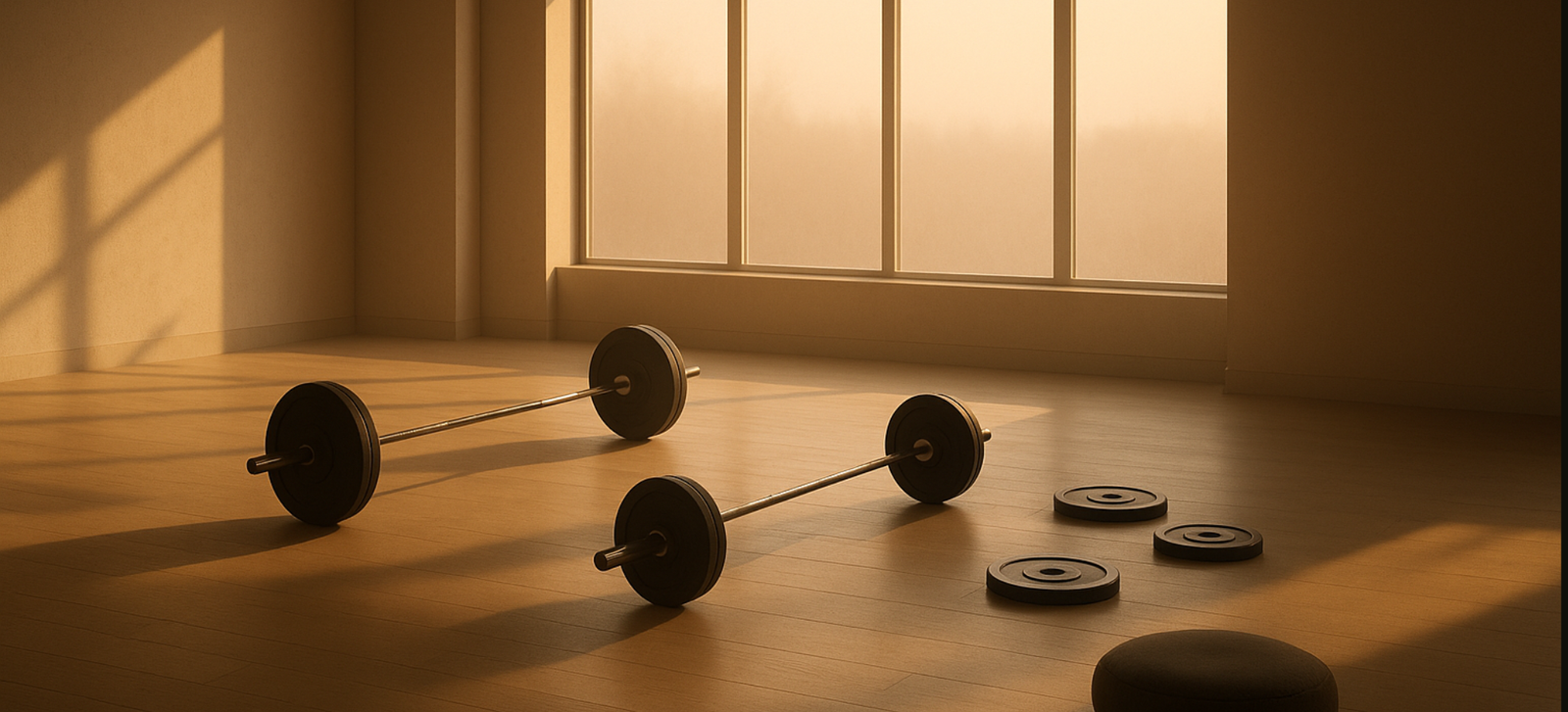Discover how Buddhist emptiness transforms your training. From pre-workout rituals to personal records, learn why letting go creates the strongest foundation for strength.
I stopped taking pre-workout supplements two years ago.
Not because they don’t work. They absolutely do. The caffeine buzz, the tingles, the feeling like you could deadlift a small car—it’s all real.
I stopped because I discovered something better.
It happened on a Tuesday morning when I forgot my usual pre-workout ritual. No supplement powder. No pump-up playlist. No mental rehearsal of the weights I was going to conquer.
I walked into the gym completely empty. Tired. Uninspired. Ready for a mediocre workout.
Instead, I had the best training session of my life.
That’s when I discovered shunyata in the squat rack.
The Philosophy of No-Thing
Shunyata is a Sanskrit term often translated as “emptiness” or “voidness.” But it doesn’t mean nothingness in the way we usually think about it.
Buddhist philosopher Nagarjuna explained shunyata as the absence of inherent existence—the understanding that nothing exists independently, permanently, or with fixed characteristics. <cite>¹</cite> Everything arises in dependence upon causes, conditions, and relationships.
In practical terms? It means letting go of the stories you tell yourself about who you are, what you can lift, and how your workout “should” go.
The Pre-Workout Paradox
Most pre-workout supplements work by creating artificial intensity. Stimulants jack up your nervous system. Nootropics sharpen your focus. Pump ingredients flood your muscles with blood.
You feel ready for war.
But here’s the paradox: the more amped up you get, the tighter you become. The tighter you become, the less efficient your movement. The less efficient your movement, the more energy you waste fighting yourself.
Sports scientist Dr. Timothy Noakes’ research on the “central governor theory” suggests that our perceived limits are often neurological rather than physiological. <cite>²</cite> When we approach training with intense expectations and ego investment, we actually create mental barriers that limit performance.
The Empty Approach
Training with shunyata means approaching each workout like you’re meeting the weights for the first time.
No preconceptions about what you can or can’t lift. No attachment to previous performances. No identity wrapped up in being “strong” or “dedicated” or “hardcore.”
Just pure presence with whatever shows up.
Zen master Suzuki Roshi called this “beginner’s mind”—approaching each moment with fresh awareness, regardless of experience. <cite>³</cite> In the weight room, beginner’s mind isn’t just spiritual practice—it’s optimal performance strategy.
The Neuroscience of Letting Go
When you release expectations, something interesting happens in your brain.
Dr. Judson Brewer’s research at Yale shows that letting go of goal-directed thinking activates the brain’s default mode network in a more integrated way, leading to improved flow states and creative problem-solving. <cite>⁴</cite> You stop micromanaging your performance and allow your body’s natural intelligence to take over.
I’ve experienced this countless times. The sets where I stop thinking about technique and just move. Where I stop counting reps and just respond to what my body needs. Where I stop trying to lift a certain weight and just see what wants to happen.
Those are always my best workouts.
The Practice of No-Practice
Here’s how I’ve learned to cultivate emptiness before training:
Arrival Ritual: I sit in my car for two minutes before entering the gym. Not planning my workout or psyching myself up. Just breathing and releasing any agenda I’m carrying from my day.
Equipment Meditation: Before touching any weight, I stand quietly and feel my feet on the ground. I notice the temperature of the air, the sounds around me, the quality of light. I arrive fully in my body and the present moment.
Intentional Non-Intention: Instead of setting specific goals (“I’m going to PR today”), I set an openness intention (“I’m here to listen to what my body needs”).
Buddhist teacher Pema Chödrön writes, “You are perfect as you are, and you could use a little improvement.” <cite>⁵</cite> This captures the empty approach perfectly—complete acceptance of your current state combined with openness to growth.
The Ego’s Last Stand
The hardest part about training with emptiness isn’t the physical practice—it’s dealing with ego backlash.
Your mind will resist this approach. It wants to strategize, compare, achieve, prove. It wants to turn your workout into a performance that validates your identity.
“But what about progressive overload?” “How will I track gains?” “Isn’t this just lazy?”
These thoughts arise from what Buddhists call “grasping mind”—the compulsive need to control outcomes and accumulate achievements.
The empty approach doesn’t abandon goals or progress. It holds them lightly. You still track your lifts, but you’re not attached to the numbers. You still push yourself, but you’re not forcing outcomes.
The Weight of No-Weight
Three months into practicing shunyata in the gym, I noticed something unexpected: I was getting stronger faster.
Not because I was training harder, but because I was training smarter. Without the pressure to perform, I naturally gravitated toward better form. Without the need to impress anyone (including myself), I took appropriate rest between sets. Without ego driving my choices, I picked weights that challenged me without destroying me.
Exercise physiologist Dr. Brad Schoenfeld’s research confirms that training with moderate intensity and perfect form often produces better strength gains than maximum effort with compromised technique. <cite>⁶</cite> When you’re empty of ego, you naturally train more intelligently.
The Community of Emptiness
One unexpected benefit of this approach: it changes how you relate to other people in the gym.
When you’re not performing an identity, you stop judging others for their performances. When you’re not attached to being the strongest person in the room, you start appreciating everyone’s unique journey.
I’ve had more genuine conversations and offered more sincere encouragement since adopting this practice. Emptiness creates space not just for better training, but for better humanity.
The Plateau as Teacher
Western fitness culture treats plateaus as problems to solve. Stagnant numbers mean you need new programs, supplements, or techniques.
Shunyata reframes plateaus as teachers.
Maybe your body needs rest, not more intensity. Maybe your nervous system needs integration time, not additional stress. Maybe your ego needs humbling, not more achievements.
Taoist philosopher Lao Tzu wrote, “The usefulness of a cup is in its emptiness.” <cite>⁷</cite> Sometimes the most useful thing you can do in training is create space rather than fill it with more effort.
The Performance Paradox
Here’s what I’ve discovered after two years of empty training: the less I care about my performance, the better it gets.
Not because I’m not trying, but because I’m not trying so hard that I interfere with my body’s natural intelligence. Not because I don’t have goals, but because I hold them lightly enough that they don’t create tension.
Sports psychologist Dr. Timothy Gallwey calls this “the inner game”—getting your mind out of the way so your body can do what it knows how to do. <cite>⁸</cite> Shunyata is the ultimate inner game strategy.
The Pre-Workout Ritual of Nothing
My current pre-workout routine looks like this:
- No supplements (except occasional coffee, held as offering not requirement)
- No music during warm-up (silence allows better body awareness)
- No planning beyond basic movement patterns
- No attachment to specific weights or rep counts
- No performance identity to maintain
Instead: presence, openness, curiosity about what wants to emerge.
The Strength of Surrender
The deepest teaching of shunyata in training is this: surrender is not weakness. It’s the ultimate strength.
When you stop forcing outcomes, you allow optimal outcomes to arise naturally. When you stop fighting your limitations, you discover possibilities beyond your imagination. When you empty yourself of who you think you should be, you make space for who you actually are.
The Liberation of No-Goals
This doesn’t mean becoming passive or uncommitted. It means becoming so present that your actions arise from wisdom rather than compulsion. So aware that you respond to what’s actually happening rather than what you think should happen.
Some days this looks like pushing harder than ever because your body is asking for challenge. Other days it looks like scaling back because your nervous system needs gentleness. Both are perfect when approached with emptiness.
The Ultimate Pre-Workout
After experimenting with every supplement, playlist, and motivation technique, I’ve learned that the best pre-workout is the absence of needing anything to be different than it is.
When you approach training from emptiness—free from agenda, performance anxiety, and identity management—you create optimal conditions for both physical adaptation and spiritual growth.
The weights become teachers rather than adversaries. Your body becomes a wise guide rather than something to conquer. The gym becomes a dojo where you practice the ultimate skill: being fully present with whatever arises.
Shunyata isn’t about becoming empty. It’s about realizing you were never as solid as you thought. And in that realization, discovering a strength that doesn’t depend on anything external.
The next time you walk into the gym, try leaving everything else outside. See what happens when your only pre-workout is presence.
You might discover, like I did, that nothing is the most powerful something you can bring to your training.
If this resonated, there’s more where it came from.
Subscribe below for weekly doses of spiritual realism, fitness philosophy, and life lessons learned the hard way.
No BS. Just truth, served with a side of sarcasm and a whole lot of heart.
Your Tuesday morning coffee just got more interesting.
Citations:
- Nagarjuna. Mulamadhyamakakarika (Root Verses on the Middle Way). Translated by Jay Garfield, Oxford University Press, 1995.
- Noakes, Timothy D. “Fatigue is a Brain-Derived Emotion that Regulates the Exercise Behavior.” Frontiers in Physiology, vol. 3, 2012, article 82.
- Suzuki, Shunryu. Zen Mind, Beginner’s Mind. Shambhala Publications, 1970.
- Brewer, Judson A., et al. “Meditation experience is associated with differences in default mode network activity and connectivity.” Proceedings of the National Academy of Sciences, vol. 108, no. 50, 2011, pp. 20254-20259.
- Chödrön, Pema. When Things Fall Apart: Heart Advice for Difficult Times. Shambhala Publications, 1997.
- Schoenfeld, Brad J., et al. “Effects of different volume-equated resistance training loading strategies on muscular adaptations.” Journal of Strength and Conditioning Research, vol. 28, no. 10, 2014, pp. 2909-2918.
- Lao Tzu. Tao Te Ching. Translated by Stephen Mitchell, Harper & Row, 1988.
- Gallwey, W. Timothy. The Inner Game of Tennis. Random House, 1974.


Leave a Reply